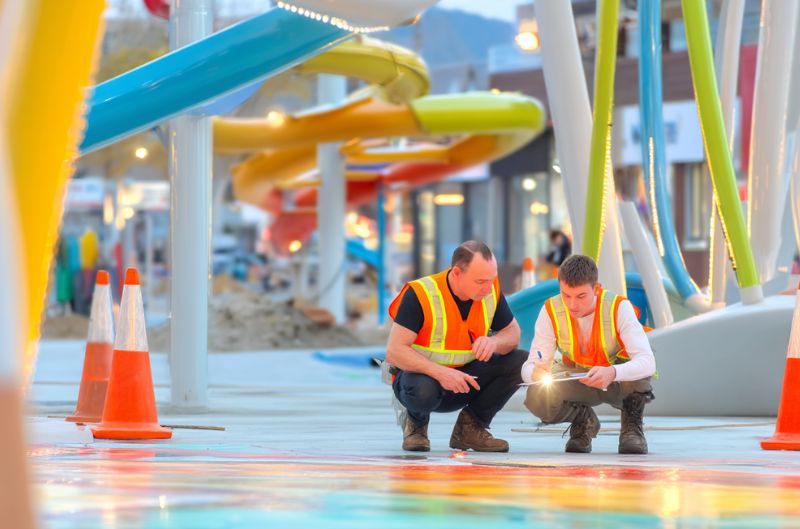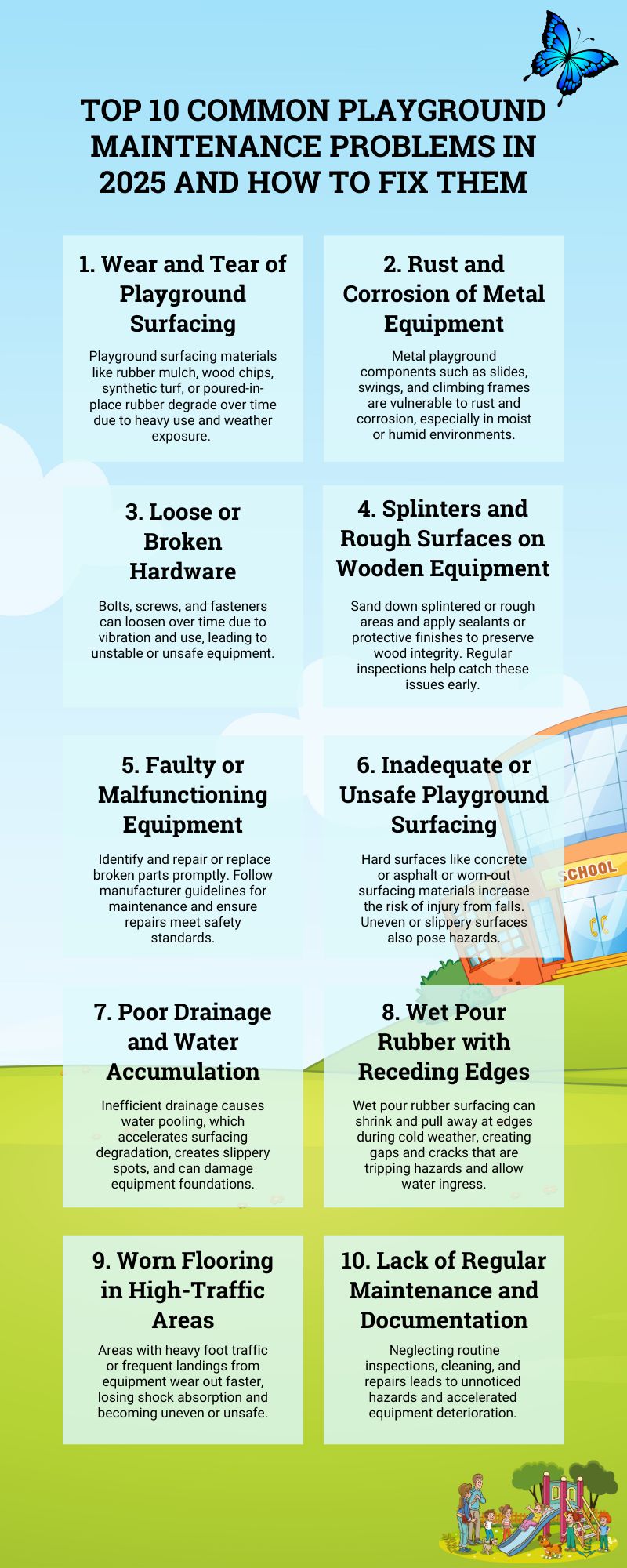
Top 10 Common Playground Maintenance Problems in 2025
Author: Austin Stanfel
Playgrounds are vital for children’s physical activity and social development, but maintaining them safely and effectively remains a challenge in 2025. Regular maintenance prevents injuries and extends the life of playground equipment and surfacing. Here are the top 10 common playground maintenance problems this year and practical solutions to keep play areas safe and enjoyable.
1. Wear and Tear of Playground Surfacing
Problem: Playground surfacing materials like rubber mulch, wood chips, synthetic turf, or poured-in-place rubber degrade over time due to heavy use and weather exposure. This can lead to compacted, uneven, or cracked surfaces that lose their cushioning ability, increasing fall injury risks and creating tripping hazards.
How to Fix: Conduct annual inspections to identify worn or damaged areas. Replenish loose-fill materials to maintain the recommended depth (usually 9–12 inches). For synthetic surfaces, consider professional maintenance or replacement every few years. Regular raking and leveling help maintain evenness and safety.
2. Rust and Corrosion of Metal Equipment
Problem: Metal playground components such as slides, swings, and climbing frames are vulnerable to rust and corrosion, especially in moist or humid environments. Rust weakens structures and can cause sharp edges, posing safety risks.
How to Fix: Inspect metal parts regularly for rust. Remove light rust with sandpaper or wire brushes, then apply protective coatings or weather-resistant paint. For severe corrosion, replace the affected parts. Rust treatment products like Rust Doctor can aid in restoration.
3. Loose or Broken Hardware
Problem: Bolts, screws, and fasteners can loosen over time due to vibration and use, leading to unstable or unsafe equipment.
How to Fix: Perform routine inspections to tighten or replace loose hardware. Maintain an inventory of replacement parts for quick repairs. Restrict access to equipment with loose components until fixed.
4. Splinters and Rough Surfaces on Wooden Equipment
Problem: Wooden playground parts can develop splinters, cracks, or rough patches, which can cause injuries.
How to Fix: Sand down splintered or rough areas and apply sealants or protective finishes to preserve wood integrity. Regular inspections help catch these issues early.
5. Faulty or Malfunctioning Equipment
Problem: Wear and tear, or poor installation, can cause swings, slides, or other equipment to malfunction, increasing injury risk.
How to Fix: Identify and repair or replace broken parts promptly. Follow manufacturer guidelines for maintenance and ensure repairs meet safety standards.
6. Inadequate or Unsafe Playground Surfacing
Problem: Hard surfaces like concrete or asphalt or worn-out surfacing materials increase the risk of injury from falls. Uneven or slippery surfaces also pose hazards.
How to Fix: Use impact-absorbing materials such as engineered wood fiber, rubber mulch, or poured-in-place rubber surfacing. Maintain proper depth and evenness. Avoid hard surfaces under play equipment 21.
7. Poor Drainage and Water Accumulation
Problem: Inefficient drainage causes water pooling, which accelerates surfacing degradation, creates slippery spots, and can damage equipment foundations.
How to Fix: Regularly inspect and clear drainage systems to prevent blockages. Grade playground areas to promote water runoff. Repair or replace surfacing damaged by standing water.
8. Wet Pour Rubber with Receding Edges
Problem: Wet pour rubber surfacing can shrink and pull away at edges during cold weather, creating gaps and cracks that are tripping hazards and allow water ingress.
How to Fix: Repair gaps with high tensile strength EPDM rubber edge strips or virgin rubber mulch bands. These secure edges and add vibrant, durable accents to the playground.
9. Worn Flooring in High-Traffic Areas
Problem: Areas with heavy foot traffic or frequent landings from equipment wear out faster, losing shock absorption and becoming uneven or unsafe.
How to Fix: Identify these zones through inspections and reinforce them with EPDM safety pads or rubber wear pads. These solutions provide extra durability without replacing large surfacing sections and can be customized with bright colors or designs.
10. Lack of Regular Maintenance and Documentation
Problem: Neglecting routine inspections, cleaning, and repairs leads to unnoticed hazards and accelerated equipment deterioration. Lack of maintenance records can increase liability risks.
How to Fix: Establish a regular maintenance schedule that includes cleaning, lubrication of moving parts, and detailed inspections. Document all maintenance activities and repairs to track playground condition and ensure compliance with safety standards.
Conclusion
Maintaining playgrounds in 2025 requires vigilance, regular inspections, and timely repairs to address common problems such as surfacing wear, rust, loose hardware, and drainage issues. Employing professional maintenance services, following manufacturer guidelines, and using durable materials can greatly enhance playground safety and longevity. Prioritizing these efforts ensures children enjoy safe, fun, and accessible play spaces year-round.


